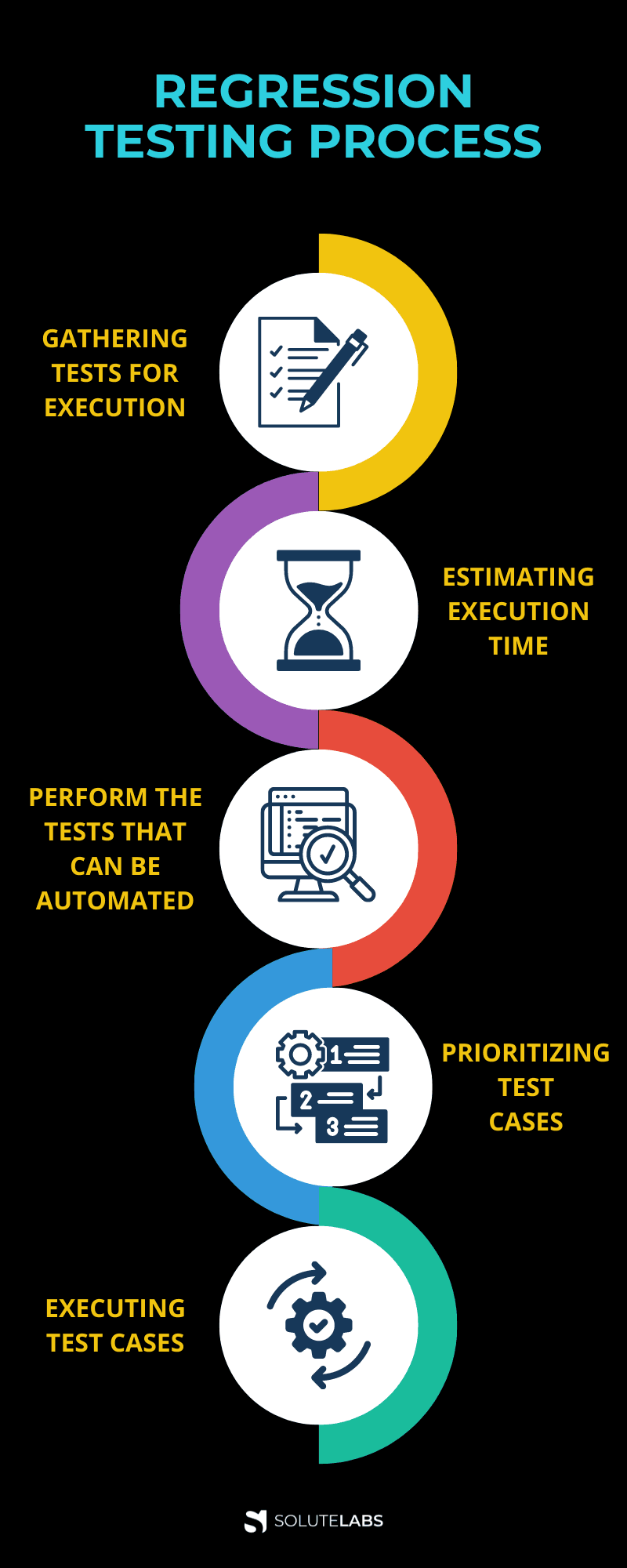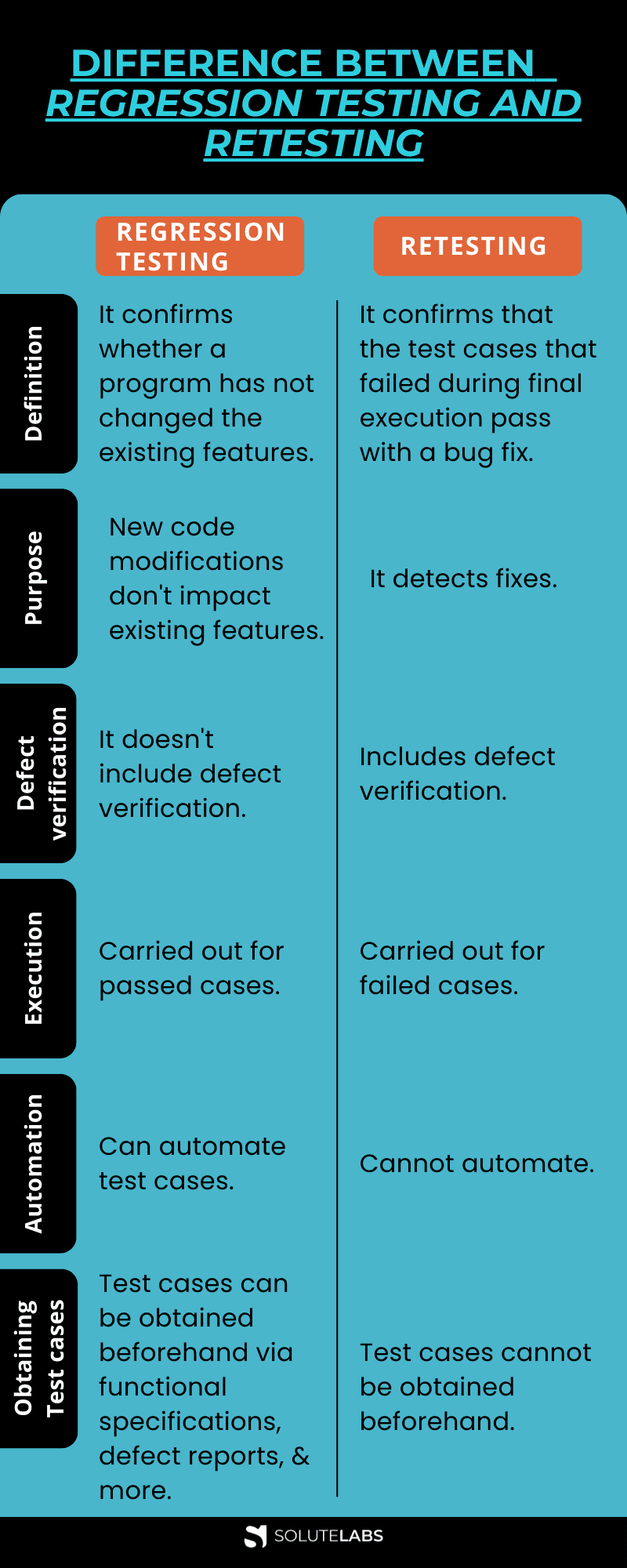The Agile software development methodology encouraged enterprises to deploy software and services. New features can address functional flaws or user feature demands. Although incremental delivery provides numerous advantages, application modifications can occasionally have unforeseen consequences on the software, such as making certain functionalities inoperable.
And that's where Regression Testing techniques are helpful! But What Is Regression Testing, and why is it important?
What is Regression Testing?
Regression Testing is a technique used in software testing to verify that an application still performs as expected after any modifications, updates, or improvements to the code. The general stability and efficiency of the current features are ensured by regression testing.
Regression Testing in Agile is used whenever a new change is made to the code to ensure proper system operations even after each update. An application typically undergoes several tests before modifications are incorporated into the main development branch.
Regression testing process verifies the overall behavior of the product. Now that you know the Regression Testing Definition, let's get to some of the use cases for a better understanding!
Examples of Regression Testing
Regression tests have many various uses. Let's look at the most well-liked list of Examples of Regression Testing.
- Bug Regression: A tester verifies if a particular bug that has been purportedly fixed has been fixed.
- General Functional Regression: A variety of comprehensive tests across the entire program to check whether recent changes have caused code instability.
- Localization Testing: If a program has been altered and rewritten in a different programming language, a tester evaluates the interface's usability and makes sure that the program adheres to its new cultural norms.
- Conversion & Port Testing: To understand that the application has been effectively ported to a new platform, many test cases are run.
- Build Verification Testing: A series of quick tests to determine whether damage to a build is fixable or not.
How is Regression Testing Done?
Regression testing is best done by developing a plan early in the development process and sticking to it until the product is released. Since we have seen the Regression Testing Examples, here's an overview of the Regression Testing Process.

- Gathering tests for execution: Gathering all the cases a QA expert plans to rerun is the first stage in creating a regression test strategy. The key to a smart selection includes identifying test cases in error-prone areas and complex cases related to boundary-value or integration.
- Estimating execution time: The next step is calculating the time to run the chosen test cases. The QA team's preparation of regression tests, the generation of test data, the review of all test cases, and others are a few aspects that influence execution time.
- Perform the tests that can be automated: The QA team can choose which Regression Test Cases to automate in this step depending on the findings of the exploratory testing. They may reuse the same script repeatedly with automated test cases quicker than manual testing. The simplest approach to prevent ambiguities within the team and maintain the order of reports is to divide manual and automated tests into two distinct groups.
- Prioritizing test cases: Assemble every test case and evaluate them according to high, medium, and low priority. The functionality and user involvement of the product will determine its priority.
- Priority 0: Critical test cases; the core functionalities.
- Priority 1: Essential features that are not core functionality.
- Priority 2: Technical debts.
- Executing test cases: It's now time to run each test case individually and determine whether or not the product is functioning properly. Depending on the need, one can choose between Regression Testing Automation and manual. The test cases can be run more quickly for advanced regression testing by using Regression Testing Tools like Watir, Selenium, and QTP.
Also, Read: QA Vs Developer: Whose responsibility is to do app testing?
What are the Different Regression Testing Techniques?
Since we got a good understanding of Regression Testing Meaning, let's know its different techniques. The four most common ways to conduct regression testing are:
- Regression Test Selection
Regression testing can only restrict the relevant components that the changes can impact. You can apply fewer, more pertinent test cases by focusing on the connected regions, reducing the time and work required for regression testing. - Test Case Prioritization
Test cases that must be included and run in the regression testing procedure might be prioritized. It should be prioritized based on factors like failure rate, business effect, and gradually introduced functionalities. - Retest All
All these test cases in the test suite must run once again to ensure no issues are caused during the code modifications. Compared to the other procedures, this one is more time- and resource-intensive. - Hybrid
The hybrid approach combines test case prioritization with regression test selection. Choose only the repeated test cases based on priority rather than the whole test suite.
What Are the Types of Regression Testing?
There are mainly 7 types of regression testing practices.
- Corrective: When there hasn't been any source code modification to your application, corrective regression testing is a good choice, as it tests the existing functionalities.
- Unit: Here, the code is tested in isolation, blocking any dependencies on the unit to enable independent testing without any inconsistencies.
- Progressive: Advanced testing is the best Regression Testing Type for modifying the testing requirements and creating new test cases.
- Selective: In selective testing, the test coverage is restricted to a subset of already-created test cases.
- Partial: Partial regression ensures that the code still functions after modifications have been made and the new unit is integrated with older or existing code.
- Complete: Complete regression is conducted when several modules are affected by a code change, and the influence of any module's modification on another is unclear.
- Retest-All: The major goal of this testing is to run through each test case again to ensure no issues are caused by changes to an application's source code.
Though the regression testing process is robust and helps mitigate risks, it is complex. Let's evaluate the advantages and Regression Testing Challenges.
Advantages of Regression Testing
The Benefits of Regression Testing are:
- It raises the level of product quality.
- It guarantees that bug patches or additions don't affect the product's current functionality.
- This testing can be done with automation tools.
- It will guarantee that already-fixed problems don't come up again.
Disadvantages of Regression Testing
The disadvantages of Software Regression Testing are:
- It can be time-consuming without automation.
- Whenever the code is changed, you must perform.
- A very repetitive process may impact the agile sprint.
- It requires you to write difficult test cases.
Difference Between Regression Testing and Retesting:
What's the difference between Regression Testing and Retesting? Below is a comparison table for the two.

What is Regression Testing in Agile?
Agile Regression Testing enables development teams to focus on new functionality while preserving stability with each successive product release. Teams use regression testing to ensure that tested software functions after every change.
A few people prefer regression testing, the "stepchild" of agile testing, yet supporting the high velocity that agile teams aim to accomplish is necessary. Agile involves rapid build cycles and ongoing additions of new features to the program.
Regression Testing in Agile is crucial because of this. A testing team should create the regression suite from the beginning of product development for successful regression testing in agile. The rapid regression testing process includes Retest all, Selective retesting, and Prioritized retesting.
Regression Testing Tools
Regression testing costs will rise if the program is frequently modified. Hence, automation is feasible here. That's when you need regression testing tools.
- Selenium: One of the best for browser-based or cross-platform regression testing. It offers automated test scripts using datasets and is ideal for in-depth quality assurance testing on a big scale.
- Watir: Ruby-based Watir is an open-source regression testing tool. This application allows testers to create test cases that are simple to read and comprehend and have interactive features.
- Subject7: A cloud-based, "truly codeless" test automation tool called Subject7 allows anyone to become an automation expert while unifying all testing on a single platform.
- Rational Functional Tester: IBM developed Rational Functional Tester (RFT), an advanced testing tool that supports several types of testing, including regression, functional, and data-driven testing.
- Katalan Studio: A complete solution for automated regression testing is offered by Katalan Studio. It attempts to simplify and open up the testing process to new testers.
Also, Read: Why Mobile Automation testing is a must for your App
Why is Regression Testing Important?
The reasons listed below make regression testing execution a crucial procedure:
- Determines whether new programming code is functional.
- It ensures that new coding doesn't interfere with the existing codes.
- Ensures that there are no flaws or issues after applying software upgrades.
- It makes it possible to retest current software after application updates.
- Validates code functionality while ensuring its compatibility with the existing features.
If you're already familiar with regression testing fundamentals, you might want to explore advanced Python testing frameworks that take your automation strategy to the next level.
Future of Regression Testing
Regardless of the software development and quality assurance procedures the company employs, creating a clear and varied testing strategy with automated Regression Testing Best Practices at its core is essential.
With that, you can help keep projects within budget, maintain your team's productivity, and, most importantly, prevent unexpected bugs from harming your products and your business's bottom line.
